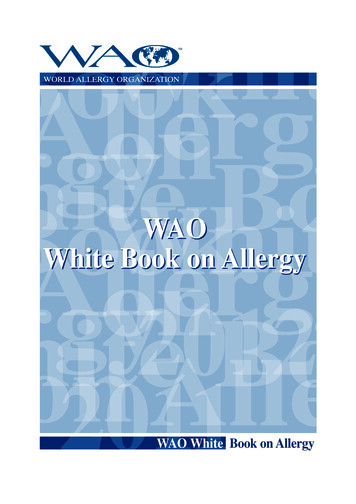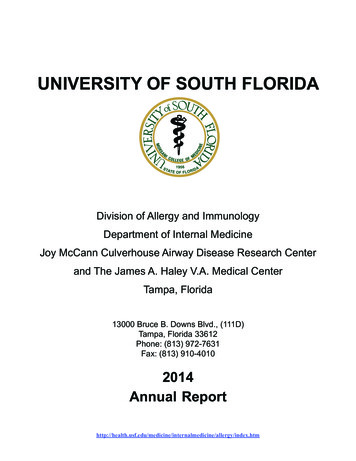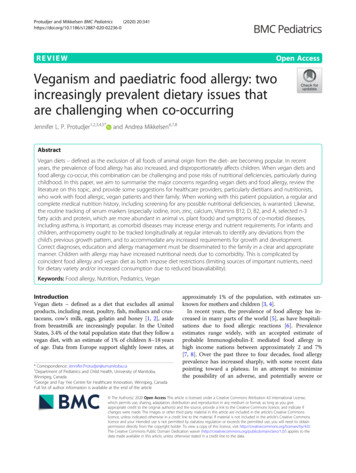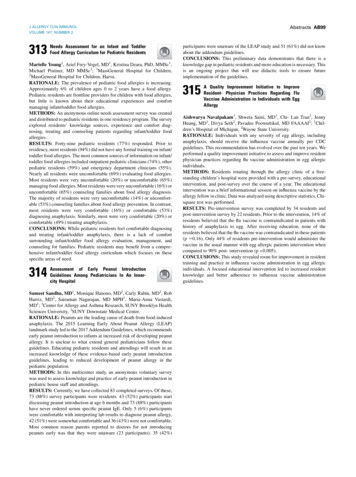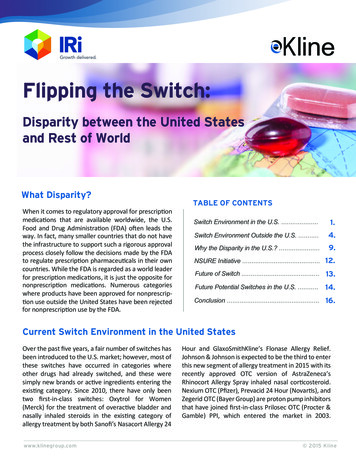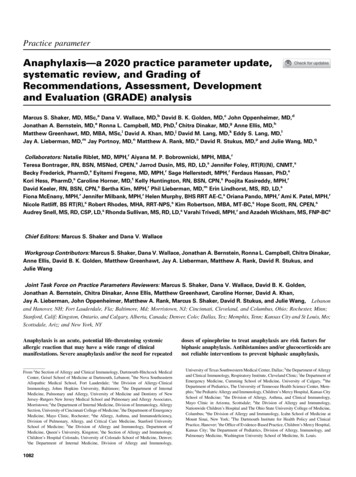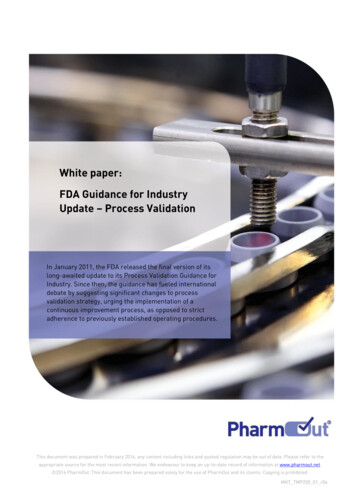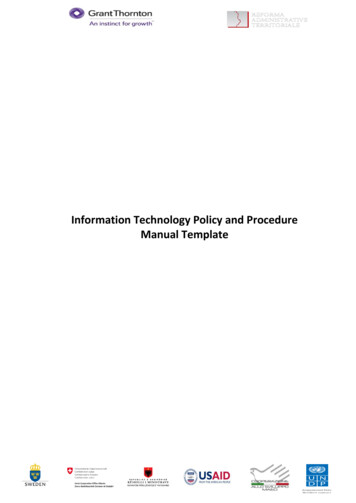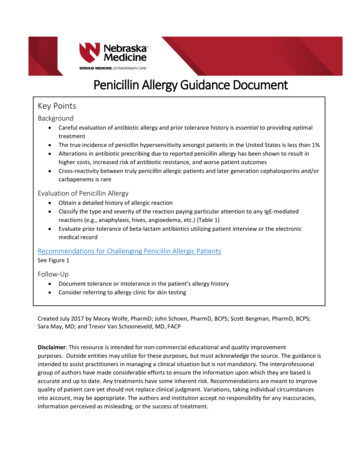
Transcription
Penicillin Allergy Guidance DocumentKey PointsBackground Careful evaluation of antibiotic allergy and prior tolerance history is essential to providing optimaltreatmentThe true incidence of penicillin hypersensitivity amongst patients in the United States is less than 1%Alterations in antibiotic prescribing due to reported penicillin allergy has been shown to result inhigher costs, increased risk of antibiotic resistance, and worse patient outcomesCross-reactivity between truly penicillin allergic patients and later generation cephalosporins and/orcarbapenems is rareEvaluation of Penicillin Allergy Obtain a detailed history of allergic reactionClassify the type and severity of the reaction paying particular attention to any IgE-mediatedreactions (e.g., anaphylaxis, hives, angioedema, etc.) (Table 1)Evaluate prior tolerance of beta-lactam antibiotics utilizing patient interview or the electronicmedical recordRecommendations for Challenging Penicillin Allergic PatientsSee Figure 1Follow-Up Document tolerance or intolerance in the patient’s allergy historyConsider referring to allergy clinic for skin testingCreated July 2017 by Macey Wolfe, PharmD; John Schoen, PharmD, BCPS; Scott Bergman, PharmD, BCPS;Sara May, MD; and Trevor Van Schooneveld, MD, FACPDisclaimer: This resource is intended for non-commercial educational and quality improvementpurposes. Outside entities may utilize for these purposes, but must acknowledge the source. The guidance isintended to assist practitioners in managing a clinical situation but is not mandatory. The interprofessionalgroup of authors have made considerable efforts to ensure the information upon which they are based isaccurate and up to date. Any treatments have some inherent risk. Recommendations are meant to improvequality of patient care yet should not replace clinical judgment. Variations, taking individual circumstancesinto account, may be appropriate. The authors and institution accept no responsibility for any inaccuracies,information perceived as misleading, or the success of treatment.
Overview of Beta-lactam Allergic ReactionsTable 1: Gell and Coombs Classification of Allergic ergen binds to IgE on basophilsor mast cells, resulting in releaseof inflammatory mediators.Anaphylaxis, hypotension,angioedema, urticaria, shortnessof breath, chest tightnessWithin 30min to 2hoursCytotoxicCell destruction occurs because ofcell-associated antigen thatinitiates cytolysis by antigenspecific antibody (IgG or IgM).Most often involves bloodelements.Drug induced hemolytic anemia,thrombocytopenia,granulocytopeniaTypically 72 h toweeksIIIImmunecomplexAntigen–antibody complexes formand deposit on blood vessel wallsand activate complement. Resultis a serum sickness-like syndrome.Fever, rash, lymphadenopathywith arthralgia 72 h toweeksIVCellmediated(delayed)Antigens cause activation of Tlymphocytes, which releasecytokines and recruit effector cells(e.g., macrophages, eosinophils).Delayed maculopapular rash,allergic contact dermatitis, Acuteinterstitial Nephritis, Druginduced hepatitis, SCARs (DRESS,AGEP, SJS, TEN) 72 hIIPresentationTypicalOnsetTypeAbbreviations: SCAR (Severe Cutaneous Adverse Reaction), DRESS (Drug Reaction with Eosinophilia and SystemicSymptoms), AGEP (acute generalized exanthematous pustulosis), SJS (Stevens Johnson Syndrome), TEN (toxicepidermal necrolysis)Penicillin Allergy Overview and ManagementEpidemiology Penicillin allergy is common with a reported prevalence of 8% of patients in the United States 2The true incidence of penicillin allergy amongst those with a reported allergy is less than 10%3In a study conducted at Nebraska Medicine in 2015, beta-lactam allergy accounted for 45.7% ofdocumented antibiotic allergies4o Majority classified as cutaneous reactions or undocumented (rash 19.1%, hives 20.2%, orundocumented 17.6%)o Only 11.2% of allergic reactions documented were classified as severe IgE mediated(anaphylaxis 3.3% and angioedema 7.9%)2
Statement of the Problem Prescribing broad spectrum antibiotic agents in patients with reported penicillin allergy can lead tohigher costs, increased risk of antibiotic resistance, and worse patient outcomes2,5,6Careful evaluation of antibiotic allergy and prior tolerance history is essential to provide optimaltreatmentIncidence of Cross-Reactivity Early studies reported inflated cross-reactivity rates between penicillin and cephalosporin agents dueto cephalosporin contamination with benzylpenicillin7Cross-reactivity between penicillin and cephalosporin agents is usually caused by side chainrecognition7Table 2: Beta-Lactam Cross-Reactivity in Penicillin Allergic PatientsDrug Class and AvailableFormulary AgentsEstimated CrossReactivity3,7Recommendations for Challenge in Penicillin AllergicPatients Results are influenced by two large trials conductedwhen early cephalosporin agents werecontaminated with penicillin Inconsistent definitions of allergic reaction resultingin overestimation of cross-reactivity Patients allergic to ampicillin should avoidcephalosporins with identical R-group side chains(cephalexin and cefaclorNF) Patients allergic to penicillin G should avoid usingcephalosporins with identical R-group side chains(cefoxitin) Patients allergic to amoxicillin should avoidcephalosporins with identical R-group side chains(cefadroxilNF and cefprozilNF)1st GenerationCephalosporin(cefazolin, cephalexin)1.9 – 7.9%2nd GenerationCephalosporin(cefuroxime, cefoxitin)1.9%3rd GenerationCephalosporin(ceftriaxone, ceftazidime)0.7% Generally considered safeAdvanced (4th/5th)Generation Cephalosporin(cefepime, ceftolozanetazobactam, ceftarolineNF)N/A Minimal data availableGenerally considered safeCarbapenem(meropenem, ertapenem)1% Risk profile similar to general population (noincreased risk of reaction) Cross-reactivity is highly unlikelyPatients allergic to ceftazidime should avoidaztreonam due to side chain similarityMonobactam(aztreonam) 1%NF non-formulary at Nebraska Medicine3
DiagnosisHow to Obtain a Detailed Assessment of Allergic ReactionInformation collected should include the following:1.2.3.4.5.6.7.8.9.10.Source of the reported allergy history (patient, family member, healthcare professional, etc.)Specific agent prescribed and infection treatedDose and route of medicationSigns and symptoms experienced along with timing of onset of the reaction in relationship to theinitiation of the medication (see Appendix B for severity classification)Whether or not the reaction necessitated urgent medical evaluationTreatment given for the reaction and responseWhether or not the patient has taken the medication again since the prior reaction (considerdiscussing brand and generic names in addition to combination antibiotics)Whether or not any recurrent signs or symptoms occurred with subsequent drug exposureConcurrent medications at the time that the reaction occurred and if any of these were newly startedOther previously tolerated antimicrobial agentsWhen to Refer for Skin TestingConsider referring a patient for penicillin skin testing if they meet any of the criteria below8 History of penicillin allergy more than 10 years agoRequires frequent antibiotic useImmunosuppressed state (e.g., solid organ transplant patient or patient undergoing chemotherapy)Planning for elective surgeryMultiple antibiotic allergiesAnaphylaxis when beta-lactam agent was administered concurrently with multiple other agentsPenicillin Allergy Management Algorithm1. Obtain allergic reaction history, determine classification (Table 1) and severity of reaction2. Evaluate prior antibiotic tolerance historya. Review allergy documentation in EPIC to determine if previously tolerated beta-lactams arenotedb. Review previously prescribed antibiotics using the medication tab in the chart review sectioni. For ease of viewing, apply filter by therapeutic class and chose “antibiotics”ii. See Appendix A for additional information3. See Figure 1 for management recommendations in patients WITH or WITHOUT prior tolerancehistoryFollow-Up Documentation Recommendations If patients have tolerated the antibiotic for which they describe an allergy, delete the allergy withinthe electronic medical record and treat patients according to institutional guidelinesIf full-dose or graded challenge is tolerated (per Figure 1), document in penicillin allergy sectionwithin the comments of the allergy (drug name and date of tolerance)4
Figure 1: Recommendations for Challenging Penicillin Allergic PatientsMild Reaction(Examples: itching, minor rash(not hives), maculopapular rash)Gell and Coombs Type I Reaction(Examples: anaphylaxis, angioedema, wheezing, laryngealedema, hypotension, or hives/urticaria)ORORDocumented intolerance/sideeffectUnknown reaction without mucosal involvement, skindesquamation, or organ involvementUse any generationcephalosporin(full dose)Previously Tolerated BetaLactamGell and Coombs Type II - IVMajor Reactions(Examples: serum sickness, SJS,TEN, DRESS syndrome, orhemolytic anemia)NO Previous Beta-LactamToleranceUse guideline-appropriate nonbeta-lactam agent (table 3)ORIf non-allergic adverse event(e.g., nausea, diarrhea, fainting),use different agent in same classAND/ORConsult Infectious DiseaseAvoid using penicillins,cephalosporins, or carbapenemsORUtilizing PreviouslyTolerated BetaLactamUtilizing DifferentAgent than BetaLactam PreviouslyToleratedReaction OccurredWithin 10 YearsUse 3rd or 4th generation cephalosporinsor carbapenems by graded challengeUse guidelineappropriate nonbeta-lactam agent(table 3)ORAdminister agentvia normal dosingAztreonamReaction OccurredGreater than orEqual to 10 YearsAgoAND/ORConsult Infectious DiseaseORUse guideline-appropriate non-betalactam agent (table 3)AztreonamORAND/ORConsult Infectious DiseaseConsult InfectiousDisease5
Table 3: Examples of Non-Beta-Lactam Agents Aminoglycoside (e.g., gentamicin, tobramycin, or amikacin)Anti-MRSA agents (e.g., vancomycin, daptomycin, or linezolid)ClindamycinFluoroquinolones (e.g., levofloxacin, ciprofloxacinNF)Macrolides (e.g., azithromycin or yclines (e.g., doxycycline, minocycline)Graded Challenge (or Test Dose Procedure)Background Graded challenges are a method of cautiously administering a drug when the risk of allergic reactionis lowGraded challenges are not desensitization and should be used as directed in Figure 1Patients who tolerate a graded challenge prove they are not allergic to the drug usedOnce a patient passes a graded challenge, normal dosing can be performed with subsequent use, aslong as no new reaction has developedo When a patient passes a graded challenge, document this within the allergy section of EPICin the comments of the related medication allergyIf challenge is passed to same medication listed as an allergy, their allergy designation should bedeleted from the electronic medical recordDosing Recommendations Utilize the “Graded Challenge” order set and select the 3rd/4th generation cephalosporin orcarbapenem agent required for treatment1. Time 0 minutes: administer 1/100th therapeutic dose2. Time 30 minutes: administer 1/10th therapeutic dose3. Time 60 minutes: administer full therapeutic doseMonitoring Recommendations Beta-blockers can blunt the effects of epinephrine. If patient is on a beta-blocker, next dose shouldbe held and challenge scheduled for the following morning prior to first dose of day.Monitor patients for symptoms of allergic reaction between each concentration changeObtain vitals at baseline and prior to each drug administrationRecommend allergy kit to be stored at the bedside throughout procedureo Kit should contain epinephrine, diphenhydramine and hydrocortisoneo Only administer these medications in the setting of an allergic reaction (see CP RX 14)o Do not pre-treat with antihistamines or glucocorticoidsContact primary team immediately if reaction developsGraded challenge can be conducted on all inpatient units, progressive care, and/or intensive careunit6
Appendix AEvaluating past antibiotic tolerance in EPIC medical record.1. Select “Chart Review” on the left panel of the patient’s electronic medical record2. Select the “Meds” tab in the chart review section3. Apply a “Filter” in the selection plane below the medications tab4. Select the “Therapeutic Class” filter followed by the class “Antibiotics”The results will show both inpatient (IP) and outpatient (AMB) antibiotics a patient was prescribed atNebraska Medicine or with affiliated providers.7
Appendix BTable 4: World Allergy Organization Immunotherapy Systemic Reaction Grading System9GradeCharacteristicsSigns or symptoms of one organ system presentCutaneous Generalized pruritus, urticaria, flushing, or sensation of heat or warmth Angioedema (not laryngeal, tongue or uvular)1Upper Respiratory Rhinitis (e.g., sneezing, rhinorrhea, nasal pruritus and/or nasal congestion) Throat-clearing (itchy throat) Cough perceived to come from the upper airway, not the lung, larynx, or tracheaConjunctival Conjunctival erythema, pruritus or tearingOther Nausea, metallic taste, or headacheSigns or symptoms of more than one organ system present (see above in addition to thefollowing criteria)2Lower Respiratory Asthma: cough, wheezing, shortness of breath (e.g., less than 40% PEF or FEV1 drop,responding to an inhaled bronchodilator)Gastrointestinal Abdominal cramps, vomiting, or diarrhea345Other Uterine crampsLower respiratory Asthma (e.g., 40% PEF or FEV1 drop, NOT responding to an inhaled bronchodilator)Upper respiratory Laryngeal, uvula or tongue edema with or without stridorLower or Upper Respiratory Respiratory failure with or without loss of consciousnessCardiovascular Hypotension with or without loss of consciousnessDeath8
References1Solensky R, Khan DA, Bernstein IL, et al. Drug Allergy: An Updated Practice Parameter. Ann AllergyAsthma Immunol 2010; 105: 273e1-78.2Macy E. Penicillin and beta-lactam allergy: epidemiology and diagnosis. Curr Allergy Asthma Rep2014; 14: 476-83.3Pichichero ME. A Review of Evidence Supporting the American Academy of PediatricsRecommendation for Prescribing Cephalosporin Antibiotics for Penicillin-Allergic Patients. Pediatrics2005; 115: 1048-57.4Clarey D, Rolek K, Lyden E, Van Schooneveld TC. Impact of Antibiotic Allergies on Patient Care at anAcademic Hospital. Poster presented at: American College of Physicians meeting; 2015; Omaha, NE.5van Dijk SM, Gardarsdottir H, Wassenberg MW, Oosterheert JJ, de Groot MC5, Rockmann H. The HighImpact of Penicillin Allergy Registration in Hospitalized Patients. J Allergy Clin Immunol Pract2016;4(5):926-31.6Su T, Broekhuizen BDL, Verheij TJM, Rockmann H. The impact of penicillin allergy labels on antibioticand health care use in primary care: a retrospective cohort study. Clin Transl Allergy 2017; 7: 18-25.7Romano A, Gaeta F, Poves MFA, Valluzzi RL. Cross-reactivity among beta-lactams. Curr Allergy AsthmaResp 2016; 16: 24-36.8Legendre DP, Muzny CA, Marshall GD, Swiatlo E. Antibiotic hypersensitivity reactions and approachesto desensitization. CID 2014; 58: 1140-8.9Cox L, Larenas-Linnemann D, Lockey RF, Passalacqua G. Speaking the same language: The World AllergyOrganization Subcutaneous Immunotherapy Systemic Reaction Grading System. J Allergy Clin Immunol2010; 125: 569-74.9
is a serum sickness-like syndrome. Fever, rash, lymphadenopathy with arthralgia 72 h to weeks IV Cell-mediated (delayed) Antigens cause activation of T lymphocytes, which release cytokines and recruit effector cells (e.g., macrophages, eosinophils). Delayed maculopapular rash, allergic contact dermatitis, Acute interstitial Nephritis, Drug
